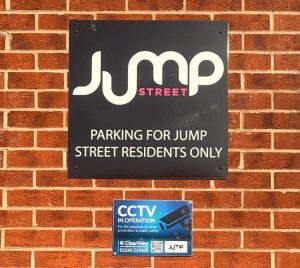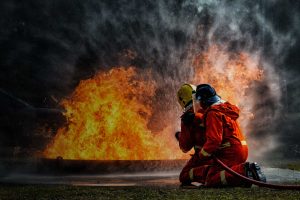Information correct as of 17.03.2023
Fire Door Regulations
Due to the importance of fire doors and their lifesaving potential, several fire door regulations are statutory and require compliance. Predominantly these regulations endeavour to ensure that fire doors, frames and associated components such as fire-rated glass, closers and ironmongery function as designed when needed.
uk fire stopping regulations
Although not exhaustive, the following information on fire door regulations aims to give an overview of the statutory requirements that must be adhered to comply with UK law.
As an accredited fire door and passive fire protection specialist, ClearView understands the importance of fire door regulations. We are certified by the International Fire Consultants who audit our fire door installation work a minimum of 4 times per year.
What Are The Fire Door Regulations Under Law?
The Regulatory Reform (Fire Safety) Order 2005
The Regulatory Reform (Fire Safety) Order 2005 sets out the responsible person’s requirements for fire safety planning and mitigation for the risk as highlighted by a fire risk assessment. Below this information is broken down into further detail:
The order’s general fire precautions state several requirements relevant to fire doors. Including:
- Reduce the risk of fire spreading
- Measures to mitigate fire
- Take steps to ensure means of escape
The order states that the ‘responsible person’ is responsible for the premises’ maintenance, repair and safety.
The responsible person must ensure the safety of employees and relevant persons who are not employees so far as reasonably practicable.
The responsible person may be the employer, building manager, business owner, Managing Director, or facilities manager, for example. Compliance with the Fire Safety Order is their statutory responsibility.
The responsible person must carry out a ‘suitable and sufficient’ risk assessment with mitigation against the risk of injury from fire. In addition, generall fire requirements must comply with the Fire Safety Order.
Fire Door Building Regulations
The building regulations 2010 uk statutory instruments 2010 no. 2214 part 8 regulation 38
Regulation 38 sets the requirements for providing fire safety information regarding the design and construction of the building. The responsible person must provide the information at the work’s completion date.
Use our Fire Door Inspection checklist to ensure your fire doors meet current regulations.
Fire Safety Management Within and Around Buildings
Information on fire safety for buildings can be found in Approved Document B, which has two volumes. Volume one provides technical guidance for dwellings such as flats as of 2019, and volume two is for all other building types. The headings below are some of the technical regulations about fire doors. Fire doors must be fitted in blocks of flats, most commercial properties and sheltered housing in the UK.
A fire doorset, is a door or shutter installed in a building to prevent the spread of fire and gaseous products.
Fire doorsets must be classified with the appropriate standards, such as BS EN 13501-2 (Fire classification of construction products and building elements). In addition, fire doorsets must be tested to meet the European standards below.
The testing is to ensure that the fire doorsets work as designed to restrict the spread of fire and smoke within a building and thus provide protection to people using escape routes.
‘People who are responsible for building work (e.g. agent, designer, builder or installer) must ensure that the work complies with all applicable requirements of the Building Regulations. The building owner may also be responsible for ensuring that work complies with the Building Regulations. If building work does not comply with the Building Regulations, the building owner may be served with an enforcement notice.’
Requirement B1 states provisions must be in place to restrict smoke and fire ingress within escape routes by using fire-resistant doorsets.
Fire Door Installation Regulations
Most new fire door installation projects state the requirements for certified installers through schemes such as the International Fire Consultants (IFC) or the Fire Door Inspection Scheme (FDIS).
This is primarily due to the level of risk involved. Unserviceable or incorrectly fitted fire doors will not perform as intended, and this presents a significant threat to life and an increased risk of property damage.
ClearView is certified for fire door specification, installation, and maintenance through the IFC, which UKAS regulates.
We encourage our clients only to use certified fire door specialists to ensure fire safety and compliance with UK statutory legislation.
Fire Door Maintenance Regulations
Fire doors must be regularly inspected because they provide a critical safety role in the event of a fire. For example, suppose a building(s) fire strategy is to be effective. In that case, fire doors must ensure that they function as designed to protect people in an emergency.
Statutory UK law on The Regulatory Reform (Fire Safety) Order 2005 You are here: UK Statutory Instruments 2005 No. 1541 PART 2 Article 17 states that fire doors must be maintained and kept in efficient working order. Meeting these statutory requirements sits with the responsible person or building owner.
Our fully qualified fire door specialists carry out ClearView’s fire door surveys. Our inspections will highlight any faults in the door and determine whether we will repair or replace your fire doors. On average, 71% of our fire door installation works are eligible for remediation. We will only replace the fire door if necessary to ensure compliance and our client’s safety.

Fire Safety in the Design and Management of Buildings
BS 9999:2017
This British Standard provides recommendations that should be in place to save the lives of building occupants and fire service members. There are also recommendations to aid with achieving fire safety objectives.
This code of practice is required for the following stakeholders:
- Architects and surveyors
- Designers
- Facilities managers
- Building managers
- Fire risk assessors
- Fire engineers
- Fire and rescue services
The standard considers human factors, such as wheelchair access, to improve safety for disabled people. Inclusive in the standard is a fire safety assessment tool that aims to complement a building’s fire safety strategy. In the new version of the standard, there is revised guidance on building exits and modified clauses on fire safety management.

Internal Fire Door Regulations
Internal fire doors are designed to separate a building into compartments. According to the fire doors FD rating, this should maintain an escape route for a set period. For example, this could be 30 minutes for an FD 30 fire door or 60 minutes for an FD 60 fire door.
For mixed-use buildings, fire doors are necessary to separate the link between a business and a habitual residence.
Every home over two storeys in height in the UK must have a fire door where a stairwell leads to a habitable room, except in bathrooms or toilets.
All non-domestic buildings must have fire doors installed. The Regulatory Reform (Fire Safety) Order 2005 provides guidance based on the horizontal and vertical escape routes that give the fastest exits. Each building should be assessed to ensure the correct rated fire doors are installed.
External Fire Door Regulations
External fire doors are critical for ensuring the viability of an escape route in a fire emergency. It is important to note that fire exit doors can be fire doors that are not fire-rated as they are predominantly used as a means of escape. As per the regulations, they must not be locked.
External fire doors are typically fitted with push bars or panic bars and are designed for doors that open outwards. They must also be labelled, such as PUSH TO OPEN.

Fire Door Ironmongery and Hardware Regulations
All ironmongery products must conform to UK construction product regulations to be used for fire doors. These products are rigorously tested to ensure that they provide adequate fire resistance following the British and European Standards. However, it is essential to note that they are not tested individually. The fire door must be tested with the products fitted to ensure that they pass.
All products that have attained the European technical assessment standard should have a CE mark. The CE mark signifies conformity and that the product has been assessed according to the harmonised European standard. The CE mark should be visible on all forms of hardware.

Fire Door Hardware Regulations
The following information and links are highlighted to guide you to the relevant type of fire door hardware. The British standards will state the individual requirements to meet the standard and the appropriate test methods that are in place.
- Fire door Hinge and hinged door regulations BS EN 1935:2002
- Emergency exit devices BS EN 179:2008
- Panic Exit devices operated by horizontal bar BS EN 1125:2008
- Mechanically operated locks BS EN12209:2016
- Controlled door closing devices BS EN 1154:1997
- Door coordinator devices BS EN 1158:1997

Fire Door Regulations for Schools
Details should be provided regarding the ‘specifications of any fire safety equipment provided, including routine maintenance schedules.’
Building Bulletin 100: design for fire safety in schools
The publication of Building Bulletin 100 (BB 100) is intended to improve fire safety in schools. The guidance aims to makes schools a much safer place for children. Below are some of the measures that are highlighted in the document:
‘Any door in a fire-resisting or compartment wall will be a fire door, designed to resist the passage of fire and smoke (when closed). Fire doors are used on escape routes to sub-divide long corridors and thus ensure that no more than a short stretch of corridor leading to an exit is likely to become smoke-logged during a fire.’
‘Within the detailed design guidance, fire doors are the normal method for preventing fire/smoke spread into/within escape routes.’
‘In general, doors on escape routes (whether or not the doors are fire doors), should either not be fitted with lock, latch or bolt fastenings, or they should only be fitted with simple fastenings that can be readily operated from the side approached by people making an escape.’
Fire Services for SchoolsTimber Fire Door Regulations
BS 8214:2016 Timber-based fire door assemblies Code of Practice
Recommendations for Timber based fire door assemblies can be found at BS 8214:2016, which is the Timber-based fire door assemblies Code of Practice. The document provides guidance for the specification, maintenance and installation of fire door sets.
The detail includes the marking of fire-resistant glass, sealing between the door and frame, fire resistance classifications, and smoke and fire seals, to name some elements.
Domestic Fire Door Regulations
Domestic fire doors still require professional installation.
If you are replacing existing doors in your home that are not fire doors, they can be replaced with a similar type of door that does not have to be fire rated.
However, to comply with UK building regulations, if you have an integral garage, they are typically fitted with a fire door rated at (FD30), designed to withstand fire and smoke for up to 30 minutes.
If your home is above three storeys in height (including loft conversions), then a fire door(s) will be required for all habitable rooms off the hallway.
It is vitally important that if you require fire doors for your home, they are fitted by certified fire door professionals. This activity is not a DIY task, and the threat from fire and compliance with UK law should be adhered to.
























